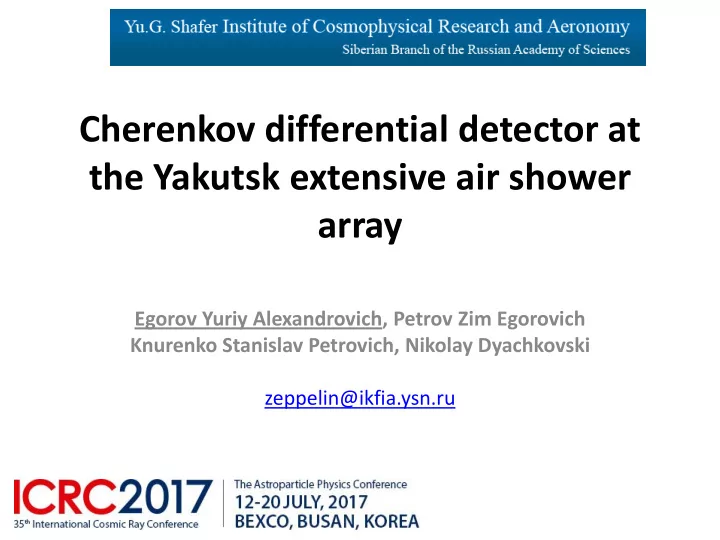

Cherenkov differential detector at the Yakutsk extensive air shower array Egorov Yuriy Alexandrovich, Petrov Zim Egorovich Knurenko Stanislav Petrovich, Nikolay Dyachkovski zeppelin@ikfia.ysn.ru
Cherenkov differential detector at the Yakutsk extensive air shower array Purpose of the instrument • Determine the spatio-temporal pattern of the development of the Cherenkov component of EAS in the atmosphere. • Determine time-related characteristics of the response in detectors (half-width at half-height, front rise time , response of detectors from extensive air showers). • Analysis of the spatial characteristics of signals in showers from ultrahigh energies cosmic rays (front and rear, curvature and thickness of shower disk, delayed particles) • Studying of the scintillation detectors response from different types of particles (electrons, gamma quanta, muons). • Studying of the ratio between hard and soft components in individual EAS of different energies and at different distances from the shower axis.
Cherenkov differential detector at the Yakutsk extensive air shower array In current configuration, Cherenkov differential detectors (CDD) are located at 250-500 m from the center of the Yakutsk EAS array. This location allows these detectors to work as a part of the array and perform multi-component EAS measurement. Geometry reconstruction( θ , φ , shower axis) is performed according to the data of the main array. One of advantages of CDD in comparison with integral Cherenkov detectors is the substantial suppression of background noise of the night sky. A low noise level is achieved by selecting a small field of view through the slit for each photomultiplier in photomosaic. The registration of Cherenkov light with CDD increases observation time of shower events, since these detectors can operate at dusk and during moonlit nights (though not full moon).
Cherenkov differential detector at the Yakutsk extensive air shower array The CDD operation principle
Cherenkov differential detector at the Yakutsk extensive air shower array Obscura 1 Installation
Cherenkov differential detector at the Yakutsk extensive air shower array Obscura 1,2
Cherenkov differential detector at the Yakutsk extensive air shower array Block diagram of the CDD registration system The CDD detectors are divided into 3 groups: photomosaic (from 9 to 10 photomultipliers), an integral Cherenkov detectors and scintillation detectors (from 5 to 8 detectors) To register the PMT response form, computers of industrial class are used, equipped with La- n10m8 PCI cards with two fast 8-bit ADCs with a sampling rate 100 MHz and 2 MB buffer memory. Within each group of PMTs output amplification is software controlled, each board serving 2 measurement channels. All stations are integrated into the network of the main array. Data transmission and time synchronization of stations are carried out over the fiber- optic network
Cherenkov differential detector at the Yakutsk extensive air shower array Software block diagram
Cherenkov differential detector at the Yakutsk extensive air shower array
An example of PMT mosaic response 6 7 8 2 3 5 1 4 9 10
Cherenkov differential detector at the Yakutsk extensive air shower array Calibration with a LIDAR • At the Yakutsk array, LIDAR measures the temperature of the upper layers and the transparency of the atmosphere. The LIDAR research station is located near the center of the Yakutsk array , which makes it possible to calibrate Cherenkov detectors without changing the output characteristics of the laser. In addition, LIDAR is used as a test of the operability of the optical part of the Cherenkov installation. • LIDAR is installed in the center of the Yakutsk array and “shoots” strictly vertically to the array plane. The control is carried out with the small Cherenkov array software, after putting the laser into operational mode of generating radiation at a wavelength l = 530 nm.
Cherenkov differential detector at the Yakutsk extensive air shower array The algorithm used in the calibration of Cherenkov receivers of a laser burst in the atmosphere at a wavelength of l = 532 nm Differential detectors of the array observe certain angles of the sky, and this circumstance makes it possible to calculate the number of photons hitting the photocathode of the PMT. The response of each PMT is related to the pre-calculated number of photons generated by laser. With the use of geometric method and by taking into account the aperture of Cherenkov receivers, we restored the heights observed by each PMT, and the parameters of the recorded pulses. This gave us the number of photons arrived from a certain height. PMT No. 1 2 3 4 5 6 7 8 9 10 Min. height, m 1134 972 852 756 681 618 567 525 1047 546 Max. height, m 1455 1197 1020 885 885 702 639 582 1314 609
Cherenkov differential detector at the Yakutsk extensive air shower array Simulation of the photomosaic response
Cherenkov differential detector at the Yakutsk extensive air shower array Conclusion • Currently the Yakutsk extensive air shower array is being modernized in order to increase the timing resolution of stations synchronization. This will give us a significant improvement in the accuracy of determining the arrival direction of initial cosmic rays ( θ , φ ) and provide the possibility to study the structure of shower disk. • Plans are to create its own trigger, which will allow us to determine the direction of EAS arrival independently of the main array. • To increase the number of the PMTs in photomosaic of CDD, which will result in increased field of view of the detector and the accuracy of determining the shape of the cascade curve of the shower development in the atmosphere.
Recommend
More recommend